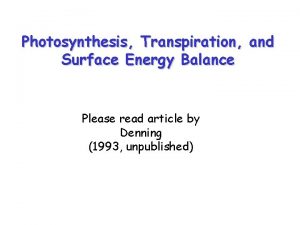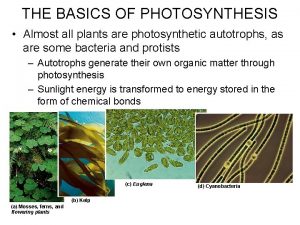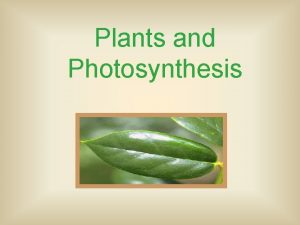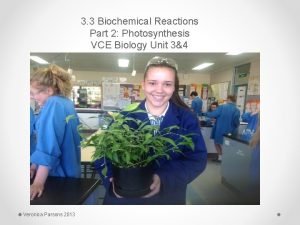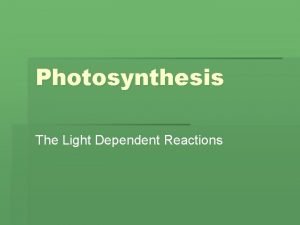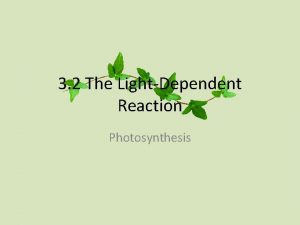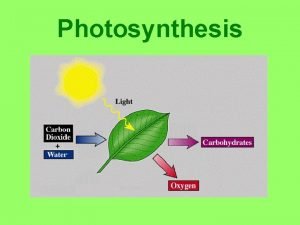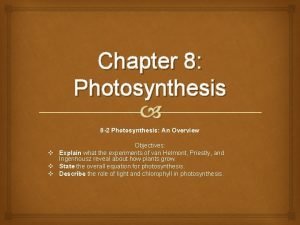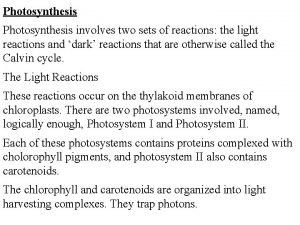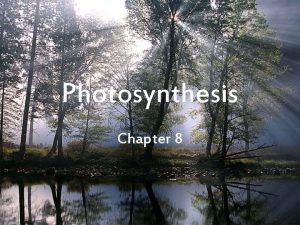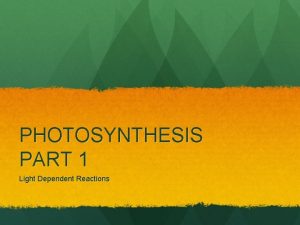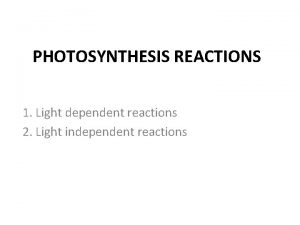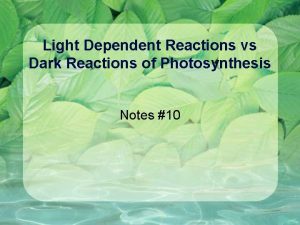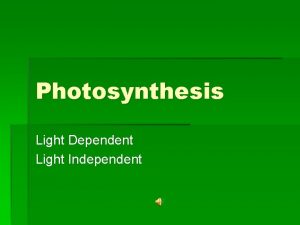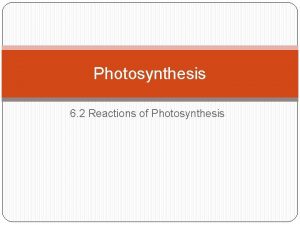PHOTOSYNTHESIS LIGHT DEPENDENT REACTIONS OVERVIEW OF LIGHT DEPENDENT













- Slides: 13

PHOTOSYNTHESIS: LIGHT DEPENDENT REACTIONS

OVERVIEW OF LIGHT DEPENDENT REACTION

LIGHT DEPENDENT REACTION: 5 STEP PROCESS 1. Light energy forces electrons to enter a higher energy level in the two chlorophyll a molecules of photosystem II. This energizes electrons or “excites” them and cause them to LEAVE the chlorophyll a molecule. This is called Oxidation. � Reduction is when the chlorophyll a molecule GAINS an electron. It gains an electron by taking one from H 2 O inside thylakoid (broken by an enzyme) � (By being reduced it allows chlorophyll a to repeat the process. ) �

REVIEW STEP ONE: (NOTICEH O DECOMPOSITION ENZYME) 2

2. The lost electron from chlorophyll a is taken by a molecule in the thylakoid membrane called the primary electron acceptor.

3. The primary electron acceptor donates the electron to a series of molecules in the thylakoid membrane. The series of molecules are called the electron transport chain. � As electrons pass through the chain they lose energy by passing it on to protons (H+). � The excited protons (H+) move into the thylakoid lumen. �

ENZYME 2 H O 4(H+) + 4(E-) + O 2 2 This decomposition enzyme replenishes electrons in PII, places protons into the thylakoid, and releases oxygen into the atmosphere.

4. Light is absorbed by Photosystem I (P 1) As in Photosystem II, electrons (e-) are excited and break away from chlorophyll a in P 1 (oxidation). � The chlorophyll a molecules lost e- is replaced by an electron which entered from photosystem II. (reduction). � As in PII, e- excited in P 1 are passed through molecules in an electron transport chain. � The chain brings e- to the thylakoid membrane where it connects with NADP+. � 5. When e- connects with NADP+ it becomes NADPH.


CHEMIOSMOSIS AND THE PROTON PUMP Adenosine Triphosphate (ATP) – is the main energy currency for cells. Chemiosmosis: 1. 2. 3. 4. Chemiosmosis relies on build-up of protons (H+) which is a concentration gradient of protons. These protons came from the water splitting enzyme and those brought into the thylakoid in PII. There is a higher concentration of protons in thylakoid which want to move out of the thylakoid. (potential energy) ATP synthase enzyme acts as a “proton pump” which harnesses energy from the flow of protons (H+) going through it.

ATP Synthase uses energy to catalyze a reaction of adensosine diphosphate (ADP) to create ATP. 5. ATP Synthases adds a phosphate atom to ADP making it ATP


Summary: � The creation of NADPH and ATP is the purpose of light dependent reactions. � These two powerful chemicals are used in the next part of photosynthesis called the Calvin Cycle.
 Structure of chlorophyll
Structure of chlorophyll Inputs of light reactions in photosynthesis
Inputs of light reactions in photosynthesis Granum
Granum How to measure photosynthesis
How to measure photosynthesis Light dependent formula
Light dependent formula Photosynthesis learning objectives
Photosynthesis learning objectives Light dependent reactions
Light dependent reactions Section 8-2 photosynthesis an overview answers
Section 8-2 photosynthesis an overview answers Chapter 9 lesson 2 photosynthesis an overview
Chapter 9 lesson 2 photosynthesis an overview What are two sets of reactions for photosynthesis
What are two sets of reactions for photosynthesis Section 8-1 energy and life
Section 8-1 energy and life Section 8-1 energy and life
Section 8-1 energy and life Redox reactions examples
Redox reactions examples Types of reactions
Types of reactions
